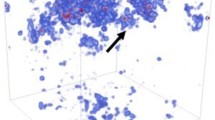Abstract
In this note we show that, a simple combination of deep results in the theory of random Schrödinger operators yields a quantitative estimate of the fact that the localization centers become far apart, as corresponding energies are close together.
Similar content being viewed by others
References
M. Aizenman, Localization at weak disorder: Some elementary bounds. Rev. Math. Phys. 6:1163–1182 (1994).
F. Germinet and S. De Biévre, Dynamical localization for discrete and continuous random Schrödinger operators. Comm. Math. Phys. 194:323–341 (1998).
R. Carmona and J. Lacroix, Spectral Theory of Random Schrödinger Operators, Birkhäuser (1990).
D. Damanik and P. Stollmann, Multi-scale analysis implies strong dynamical localization. Geom. Funct. Anal. 11(1):11–29 (2001).
J. Fröhlich and T. Spencer, Absence of diffusion in the Anderson tight binding model for large disorder or low energy. Commun. Math. Phys. 88:151–184 (1983).
L. N. Grenkova, S. A. Molchanov and Ju. N. Sudarev, On the basic states of one-dimensional disordered structures. Comm. Math. Phys. 90(1):101–123 (1983).
W. Kirsch, O. Lenoble and L. Pastur, On the mott formula for the a.c. conductivity and binary correlators in the strong localization regime of disordered systems. J. Phys. A. 36(49):12157–12180 (2003).
A. Klein and S. Molchanov, Simplicity of eigenvalues in the Anderson model. J. Stat. Phys.(122):95–99 (2006).
A. Klein, O. Lenoble and P. Muller, On Mott's formula for the acconductivity in the Anderson model, math-ph/0508007.
H. Kunz and B. Souillard, Sur le spectre des operateurs aux differences finies aleatoires. Comm. Math. Phys. 78:201–246 (1980).
N. Minami, Local fluctuation of the spectrum of a multidimensional Anderson tight-binding model. Comm. Math. Phys. 177:709–725 (1996).
S. Molchanov, The local structure of the spectrum of the one-dimensional Schrödinger operator. Comm. Math. Phys. 78:429–446 (1981).
R. Killip and F. Nakano, The global fluctuation of localization centers in the Anderson model, preprint.
B. Simon. Lifschitz tails for the Anderson model. J. Stat. Phys. 38:65–76 (1985).
H. von Dreifus and A. Klein, A new proof of localization in the Anderson tight binding model. Commun. Math. Phys. 124:285–299 (1989).
Author information
Authors and Affiliations
Corresponding author
Rights and permissions
About this article
Cite this article
Nakano, F. The Repulsion Between Localization Centers in the Anderson Model. J Stat Phys 123, 803–810 (2006). https://doi.org/10.1007/s10955-006-9086-y
Received:
Accepted:
Published:
Issue Date:
DOI: https://doi.org/10.1007/s10955-006-9086-y




